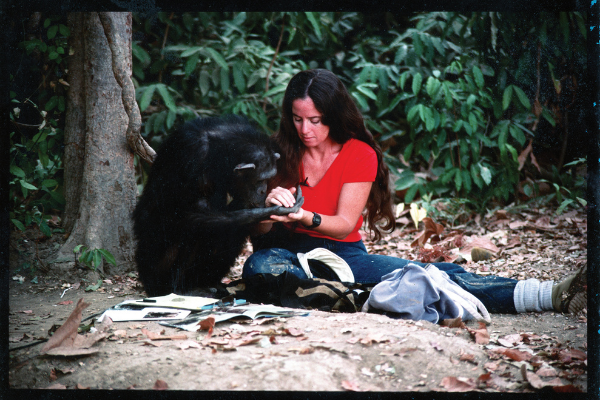Janis Carter lived as the leader of a group of chimpanzees on a remote island in Africa. What was supposed to be a three-week visit to Africa back in 1977 to help Lucy—the famous sign language chimp raised by humans—get released into the wild, turned into a permanent stay. Carter’s seemingly impossible task of giving Lucy back her freedom and a new life in the wild and her role in helping to establish the Chimpanzee Rehabilitation Project (CRP) with Stella Brewer, an island sanctuary in West Africa in the River Gambia National Park in 1979, is the subject of a Keo Films and Channel 4 documentary called “Lucy the Human Chimp,” which premiered Thursday, April 29 on HBO Max.
“The story takes us back to a very different time, but it has a powerful message for today,” said executive producer Matt Cole. Some of the CRP’s chimpanzees were voluntarily relinquished by people who had unwisely tried to make them into pets.
Others were confiscated as orphans of parents killed by hunters for bushmeat or parents who were taken for exploitive industries. But the once captive chimpanzees now enjoy the national park’s gallery forest, woodlands and swamp savannahs, free from exploitation.
In the early days when Lucy and some other chimps were let loose on the island, Carter slept in a cage. Carter, who was a graduate student in psychology at the University of Oklahoma, helped the chimpanzees become more fully themselves. She demonstrated which foods were safe, led foraging expeditions and communicated through chimp vocalizations.
Director Alex Parkinson’s gripping documentary centers on Carter’s emotionally charged first-person account of life with Lucy. This story of survival against all odds and an unbreakable friendship across the divide between species begins in 1960s suburban America with a radical experiment exploring the boundary between ape and human, and it ends decades later in the depths of a remote African jungle.
Today, the CRP is home to 140 chimpanzees, who live in four groups in relative freedom—without bars or cages—on three of the park’s five islands. In a November 2008 landmark agreement with the Gambian government, Friends of Animals agreed to help fund the 1,500-acre CRP. Friends of Animals’ support ensures that the chimpanzees receive supplemental food for a complete diet and to prevent over stripping of the island vegetation by the chimpanzees.
FoA’s support also makes possible the health monitoring that is vital to these great apes’ survival.
“Our work with Janis started more than two decades ago when we supported her chimpanzee surveys in Senegal that helped to determine where the wild populations were,” recalls Priscilla Feral, president of Friends of Animals.
“We always wanted to support a chimpanzee sanctuary in their native African lands, and we quickly discovered Janis runs the most extraordinary, unique sanctuary in the world. The chimps live on three forested islands that are also occupied by baboons and other monkeys. The water is their barrier. They’re protected from intrusions by Janis’ amazing staff.”
The film—meant to be a cautionary tale—includes home movies, archival film and photographs from the personal collection of Jane Temerlin, the psychologist who initially raised Lucy, and Carter, much of which has been previously unseen. Their story raises questions about what divides humans from apes and offers profound discoveries about the values we share with our nearest animal relatives.
“No other human has ever lived like this. It’s a privilege to tell Janis’s story for the first time,” said Parkinson. Likewise, it has been a privilege for FoA to partner with Carter to support her work.
“Janis’ selflessness, combined with her enormous ability, is so rare and what makes her such a truly, remarkable person. I don’t know anyone else like her,” Feral said.

